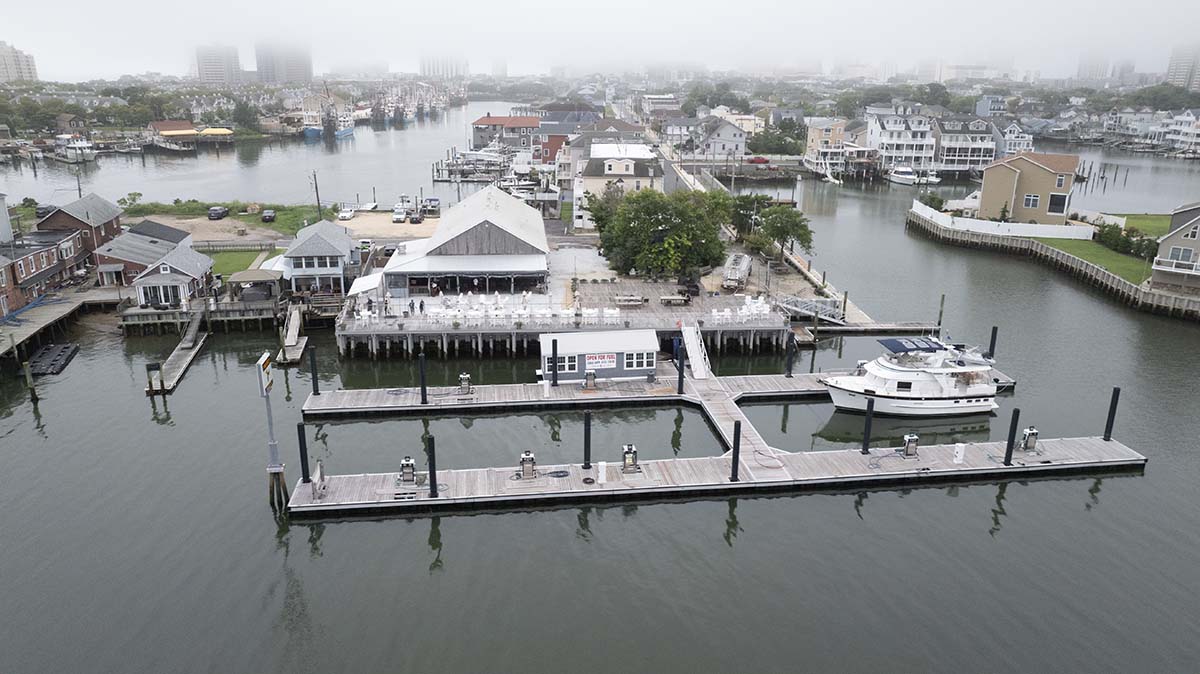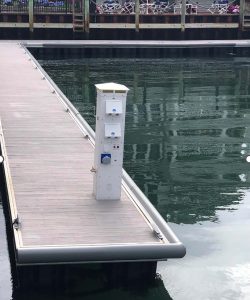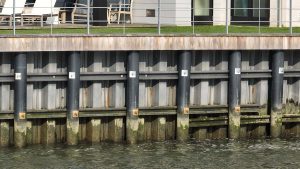
Innovative Materials Promote Safety and Sustainability
Published on October 24, 2025Marinas across the nation are beginning to rethink the materials they use, moving toward more sustainable, resilient options to fortify their infrastructure. They are investing in fiberglass-reinforced polymers (FRPs) for pilings and new fender systems for their docks – all designed to keep boaters safe and make boating more environmentally conscious.
Durability and Safety
Slammer Marine is among the forward-thinking companies responding to this shift, with an integrated dock fender system that is now in nearly 50 marinas and on hundreds of private slips and docks. Brought to market in 2016, the product includes a fender made of a waterproof foam core that is completely enclosed by a polyurethane-coated fabric – a material used in marine inflatables. It is equally designed for dock durability and boater safety.
“Bringing a boat alongside a dock looks simple, but changing wind, current, or an inexperienced crew can turn a landing into a risky maneuver,” explained Jonathan Hough, founder of Texas-based Slammer Marine. “Our system is engineered to take that worry off the boat operator. They know the Slammer fender is always in place to absorb the impact and protect the hull. Just as importantly, if a crew member or dockhand instinctively tries to fend-off, the compressible foam cushions the impact, reducing the chance of serious hand or foot injuries that could happen during a less than perfectly executed landing.”

Slammer’s fender is roughly 6 inches deep and 9 inches tall, and it comes in standard length sections of 40, 80 and 120 inches that slide horizontally into a track system affixed to the dock, creating a secure, modular, and aesthetically appealing look. Not only does this invention decrease wear and tear on docks, but it also lessens the risk of serious potential injury to crew members and marina staff, as the closed-cell foam core compresses absorbing any impact during docking.
The company is also in the process of introducing a next generation mounting system, incorporating an aluminum track design to complement its current polymer mounting track.
“We’ve heard directly from dockmasters and marina managers who report Slammer reduces or eliminates incidents of hull damage while giving operators greater confidence and peace of mind while docking. Without a need for traditional hanging fenders, Slammer eliminates the open space between the hull and dock, allowing for safer boarding.,” Hough said, referencing such clients as Brown & Howard Marina, Sail Newport, Newport Yachting Center, Hinckley Yachts, Safe Harbor New Port Cove and Cape Ann Marina. “Our customers count on the Slammer system to enhance resiliency, safety, and operator confidence every day. Slammer Marine products support higher boat utilization, a win-win for recreational boaters and marina operators.”
Long-Term Sustainability
Like the move toward newer fender systems, another growing trend in the industry involves using FRPs for pilings, rather than traditional materials like wood, steel or concrete.
“FRP is an excellent choice for the marine industry due to its high strength-to-weight ratio, excellent corrosion resistance and durability,” said Corey Sechler, the vice president of sales and civil infrastructure for Creative Composites Group, which supplies FRP products for major infrastructure markets. “This makes it suitable for constructing marine docks that can withstand harsh marine environments.”
The appeal of FRP products is simple. They do not rust or rot, and they offer electrical insulation properties and ultraviolet resistance. Because they require far less maintenance and replacement, marinas using these solutions save money and reduce waste. FRP products are particularly valuable in sensitive coastal zones, where leaching chemicals or decaying wood can damage ecosystems. Unlike some treated timber pilings, FRPs are inert, meaning they do not introduce toxins into the water. This makes them especially attractive to marinas operating near protected habitats or under strict regulatory oversight.

Every time an old dock or fender has to be replaced, it adds to a marina’s carbon footprint. By switching to longer-lasting materials, marinas are helping to keep local waters cleaner, thus protecting marine life.
As concerns about chromated copper arsenate-treated wood grow, and the limitations of steel and concrete in harsh marine environments become more evident, FRP products are emerging as a cost-effective solution in the long run, despite the initial higher investment.
“The initial investment in FRP is higher compared to traditional materials like wood or metal; however, the long-term cost savings and performance benefits often outweigh the upfront costs,” Sechler said. “FRP has a lightweight yet strong structure, non-conductive nature, impact resistance and low-maintenance requirements. These advantages make FRP a cost-effective choice for projects requiring durability, performance and long-term sustainability.”
Some of the real-world applications for these FRP products include bridge fenders, dock fendering, private docks, boat lifts, bearing piles and dolphin piles. In addition, FRP products are increasingly being used in hybrid structures that combine traditional pilings with composite reinforcements, offering the best of both worlds. These innovations highlight the material’s versatility, making it a preferred option not only for new construction but also for retrofitting existing facilities.
Sechler notes that the initial capital costs and the need for comprehensive life cycle cost analyses can pose challenges for decision-makers unfamiliar with advanced materials. A life cycle cost analysis considers all relevant costs and revenue associated with a structure over its lifetime, including manufacturing, installation, use and end of life, he said, further commenting that all things considered, FRP products tend to prove superior to alternatives on the market.
“The environmental benefits of FRPs, such as reduced emissions and lower carbon footprint, make it a sustainable choice for marine structures,” Sechler said. “By adopting FRPs, marine structures can be protected from environmental and regulatory challenges, ensuring long-term durability and compliance with sustainability goals.”
Ultimately, this evolution of marine infrastructure reflects a larger story – one of innovation meeting necessity. As storms intensify and coastlines face new pressures, marinas must embrace solutions that are built to last.
| Categories | |
| Tags |





